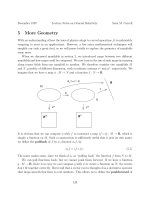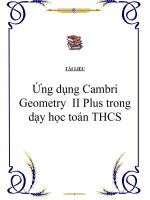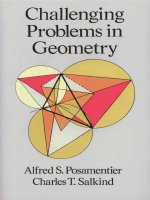More Geometry
Bạn đang xem bản rút gọn của tài liệu. Xem và tải ngay bản đầy đủ của tài liệu tại đây (319.64 KB, 35 trang )
December 1997 Lecture Notes on General Relativity Sean M. Carroll
5 More Geometry
With an understanding of how the laws of physics adapt to curved spacetime, it is undeniably
tempting to start in on applications. However, a few extra mathematical techniques will
simplify our task a great deal, so we will pause briefly to explore the geometry of manifolds
some more.
When we discussed manifolds in section 2, we introduced maps between two different
manifolds and how maps could be composed. We now turn to the use of such maps in carrying
along tensor fields from one manifold to another. We therefore consider two manifolds M
and N, possibly of different dimension, with coordinate systems x
µ
and y
α
, respectively. We
imagine that we have a map φ : M → N and a function f : N → R.
M
x
f = f
f
φ
R
R
R
m
n
µ
y
α
N
*
φ φ
It is obvious that we can compose φ with f to construct a map (f ◦ φ) : M → R, which is
simply a function on M. Such a construction is sufficiently useful that it gets its own name;
we define the pullback of f by φ, denoted φ
∗
f, by
φ
∗
f = (f ◦ φ) . (5.1)
The name makes sense, since we think of φ
∗
as “pulling back” the function f from N to M.
We can pull functions back, but we cannot push them forward. If we have a function
g : M → R, there is no way we can compose g with φ to create a function on N; the arrows
don’t fit together correctly. But recall that a vector can be thought of as a derivative operator
that maps smooth functions to real numbers. This allows us to define the pushforward of
129
5 MORE GEOMETRY 130
a vector; if V (p) is a vector at a point p on M, we define the pushforward vector φ
∗
V at the
point φ(p) on N by giving its action on functions on N:
(φ
∗
V )(f) = V (φ
∗
f) . (5.2)
So to push forward a vector field we say “the action of φ
∗
V on any function is simply the
action of V on the pullback of that function.”
This is a little abstract, and it would be nice to have a more concrete description. We
know that a basis for vectors on M is given by the set of partial derivatives ∂
µ
=
∂
∂x
µ
, and
a basis on N is given by the set of partial derivatives ∂
α
=
∂
∂y
α
. Therefore we would like
to relate the components of V = V
µ
∂
µ
to those of (φ
∗
V ) = (φ
∗
V )
α
∂
α
. We can find the
sought-after relation by applying the pushed-forward vector to a test function and using the
chain rule (2.3):
(φ
∗
V )
α
∂
α
f = V
µ
∂
µ
(φ
∗
f)
= V
µ
∂
µ
(f ◦ φ)
= V
µ
∂y
α
∂x
µ
∂
α
f . (5.3)
This simple formula makes it irresistible to think of the pushforward operation φ
∗
as a matrix
operator, (φ
∗
V )
α
= (φ
∗
)
α
µ
V
µ
, with the matrix being given by
(φ
∗
)
α
µ
=
∂y
α
∂x
µ
. (5.4)
The behavior of a vector under a pushforward thus bears an unmistakable resemblance to the
vector transformation law under change of coordinates. In fact it is a generalization, since
when M and N are the same manifold the constructions are (as we shall discuss) identical;
but don’t be fooled, since in general µ and α have different allowed values, and there is no
reason for the matrix ∂y
α
/∂x
µ
to be invertible.
It is a rewarding exercise to convince yourself that, although you can push vectors forward
from M to N (given a map φ : M → N), you cannot in general pull them back — just keep
trying to invent an appropriate construction until the futility of the attempt becomes clear.
Since one-forms are dual to vectors, you should not be surprised to hear that one-forms can
be pulled back (but not in general pushed forward). To do this, remember that one-forms
are linear maps from vectors to the real numbers. The pullback φ
∗
ω of a one-form ω on N
can therefore be defined by its action on a vector V on M, by equating it with the action of
ω itself on the pushforward of V :
(φ
∗
ω)(V ) = ω(φ
∗
V ) . (5.5)
Once again, there is a simple matrix description of the pullback operator on forms, (φ
∗
ω)
µ
=
(φ
∗
)
µ
α
ω
α
, which we can derive using the chain rule. It is given by
(φ
∗
)
µ
α
=
∂y
α
∂x
µ
. (5.6)
5 MORE GEOMETRY 131
That is, it is the same matrix as the pushforward (5.4), but of course a different index is
contracted when the matrix acts to pull back one-forms.
There is a way of thinking about why pullbacks and pushforwards work on some objects
but not others, which may or may not be helpful. If we denote the set of smooth functions
on M by F(M), then a vector V (p) at a point p on M (i.e., an element of the tangent space
T
p
M) can be thought of as an operator from F(M) to R. But we already know that the
pullback operator on functions maps F(N) to F(M) (just as φ itself maps M to N, but
in the opposite direction). Therefore we can define the pushforward φ
∗
acting on vectors
simply by composing maps, as we first defined the pullback of functions:
F F
(M)
(N)
φ
*
(V(p)) = V(p)
φ
R
φ
V(p)
*
*
Similarly, if T
q
N is the tangent space at a point q on N, then a one-form ω at q (i.e., an
element of the cotangent space T
∗
q
N) can be thought of as an operator from T
q
N to R. Since
the pushforward φ
∗
maps T
p
M to T
φ(p)
N, the pullback φ
∗
of a one-form can also be thought
of as mere composition of maps:
T M
p
φ(p)
T N
φ
*
= ω(ω)
*
φ
φ
*
ω
R
If this is not helpful, don’t worry about it. But do keep straight what exists and what
doesn’t; the actual concepts are simple, it’s just remembering which map goes what way
that leads to confusion.
You will recall further that a (0, l) tensor — one with l lower indices and no upper ones
— is a linear map from the direct product of l vectors to R. We can therefore pull back
not only one-forms, but tensors with an arbitrary number of lower indices. The definition is
simply the action of the original tensor on the pushed-forward vectors:
(φ
∗
T )(V
(1)
, V
(2)
, . . . , V
(l)
) = T (φ
∗
V
(1)
, φ
∗
V
(2)
, . . . , φ
∗
V
(l)
) , (5.7)
5 MORE GEOMETRY 132
where T
α
1
···α
l
is a (0, l) tensor on N. We can similarly push forward any (k, 0) tensor S
µ
1
···µ
k
by acting it on pulled-back one-forms:
(φ
∗
S)(ω
(1)
, ω
(2)
, . . . , ω
(k)
) = S(φ
∗
ω
(1)
, φ
∗
ω
(2)
, . . . , φ
∗
ω
(k)
) . (5.8)
Fortunately, the matrix representations of the pushforward (5.4) and pullback (5.6) extend to
the higher-rank tensors simply by assigning one matrix to each index; thus, for the pullback
of a (0, l) tensor, we have
(φ
∗
T )
µ
1
···µ
l
=
∂y
α
1
∂x
µ
1
···
∂y
α
l
∂x
µ
l
T
α
1
···α
l
, (5.9)
while for the pushforward of a (k, 0) tensor we have
(φ
∗
S)
α
1
···α
k
=
∂y
α
1
∂x
µ
1
···
∂y
α
k
∂x
µ
k
S
µ
1
···µ
k
. (5.10)
Our complete picture is therefore:
φ
*
φ
*
( )
( )
k
0
( )
k
0
l l
0
( )
0
φ
N
M
Note that tensors with both upper and lower indices can generally be neither pushed forward
nor pulled back.
This machinery becomes somewhat less imposing once we see it at work in a simple
example. One common occurrence of a map between two manifolds is when M is actually a
submanifold of N; then there is an obvious map from M to N which just takes an element
of M to the “same” element of N. Consider our usual example, the two-sphere embedded in
R
3
, as the locus of points a unit distance from the origin. If we put coordinates x
µ
= (θ, φ)
on M = S
2
and y
α
= (x, y, z) on N = R
3
, the map φ : M → N is given by
φ(θ, φ) = (sin θ cos φ, sin θ sin φ, cos θ) . (5.11)
In the past we have considered the metric ds
2
= dx
2
+ dy
2
+ dz
2
on R
3
, and said that it
induces a metric dθ
2
+ sin
2
θ dφ
2
on S
2
, just by substituting (5.11) into this flat metric on
5 MORE GEOMETRY 133
R
3
. We didn’t really justify such a statement at the time, but now we can do so. (Of course
it would be easier if we worked in spherical coordinates on R
3
, but doing it the hard way is
more illustrative.) The matrix of partial derivatives is given by
∂y
α
∂x
µ
=
cos θ cos φ cos θ sin φ − sin θ
− sin θ sin φ sin θ cos φ 0
. (5.12)
The metric on S
2
is obtained by simply pulling back the metric from R
3
,
(φ
∗
g)
µν
=
∂y
α
∂x
µ
∂y
β
∂x
ν
g
αβ
=
1 0
0 sin
2
θ
, (5.13)
as you can easily check. Once again, the answer is the same as you would get by naive
substitution, but now we know why.
We have been careful to emphasize that a map φ : M → N can be used to push certain
things forward and pull other things back. The reason why it generally doesn’t work both
ways can be traced to the fact that φ might not be invertible. If φ is invertible (and both φ
and φ
−1
are smooth, which we always implicitly assume), then it defines a diffeomorphism
between M and N. In this case M and N are the same abstract manifold. The beauty of
diffeomorphisms is that we can use both φ and φ
−1
to move tensors from M to N; this will
allow us to define the pushforward and pullback of arbitrary tensors. Specifically, for a (k, l)
tensor field T
µ
1
···µ
k
ν
1
···µ
l
on M, we define the pushforward by
(φ
∗
T )(ω
(1)
, . . . , ω
(k)
, V
(1)
, . . . , V
(l)
) = T (φ
∗
ω
(1)
, . . . , φ
∗
ω
(k)
, [φ
−1
]
∗
V
(1)
, . . . , [φ
−1
]
∗
V
(l)
) ,
(5.14)
where the ω
(i)
’s are one-forms on N and the V
(i)
’s are vectors on N. In components this
becomes
(φ
∗
T )
α
1
···α
k
β
1
···β
l
=
∂y
α
1
∂x
µ
1
···
∂y
α
k
∂x
µ
k
∂x
ν
1
∂y
β
1
···
∂x
ν
l
∂y
β
l
T
µ
1
···µ
k
ν
1
···ν
l
. (5.15)
The appearance of the inverse matrix ∂x
ν
/∂y
β
is legitimate because φ is invertible. Note
that we could also define the pullback in the obvious way, but there is no need to write
separate equations because the pullback φ
∗
is the same as the pushforward via the inverse
map, [φ
−1
]
∗
.
We are now in a position to explain the relationship between diffeomorphisms and coordi-
nate transformations. The relationship is that they are two different ways of doing precisely
the same thing. If you like, diffeomorphisms are “active coordinate transformations”, while
traditional coordinate transformations are “passive.” Consider an n-dimensional manifold
M with coordinate functions x
µ
: M → R
n
. To change coordinates we can either simply
introduce new functions y
µ
: M → R
n
(“keep the manifold fixed, change the coordinate
5 MORE GEOMETRY 134
maps”), or we could just as well introduce a diffeomorphism φ : M → M, after which the
coordinates would just be the pullbacks (φ
∗
x)
µ
: M → R
n
(“move the points on the man-
ifold, and then evaluate the coordinates of the new points”). In this sense, (5.15) really is
the tensor transformation law, just thought of from a different point of view.
φ
*
φ
n
( x)
x
y
µ
µ
µ
R
M
Since a diffeomorphism allows us to pull back and push forward arbitrary tensors, it
provides another way of comparing tensors at different points on a manifold. Given a diffeo-
morphism φ : M → M and a tensor field T
µ
1
···µ
k
ν
1
···µ
l
(x), we can form the difference between
the value of the tensor at some point p and φ
∗
[T
µ
1
···µ
k
ν
1
···µ
l
(φ(p))], its value at φ(p) pulled
back to p. This suggests that we could define another kind of derivative operator on tensor
fields, one which categorizes the rate of change of the tensor as it changes under the diffeo-
morphism. For that, however, a single discrete diffeomorphism is insufficient; we require a
one-parameter family of diffeomorphisms, φ
t
. This family can be thought of as a smooth
map R× M → M, such that for each t ∈ R φ
t
is a diffeomorphism and φ
s
◦ φ
t
= φ
s+t
. Note
that this last condition implies that φ
0
is the identity map.
One-parameter families of diffeomorphisms can be thought of as arising from vector fields
(and vice-versa). If we consider what happens to the point p under the entire family φ
t
, it is
clear that it describes a curve in M; since the same thing will be true of every point on M,
these curves fill the manifold (although there can be degeneracies where the diffeomorphisms
have fixed points). We can define a vector field V
µ
(x) to be the set of tangent vectors to
each of these curves at every point, evaluated at t = 0. An example on S
2
is provided by
the diffeomorphism φ
t
(θ, φ) = (θ, φ + t).
We can reverse the construction to define a one-parameter family of diffeomorphisms
from any vector field. Given a vector field V
µ
(x), we define the integral curves of the
vector field to be those curves x
µ
(t) which solve
dx
µ
dt
= V
µ
. (5.16)
Note that this familiar-looking equation is now to be interpreted in the opposite sense from
our usual way — we are given the vectors, from which we define the curves. Solutions to
5 MORE GEOMETRY 135
φ
(5.16) are guaranteed to exist as long as we don’t do anything silly like run into the edge of
our manifold; any standard differential geometry text will have the proof, which amounts to
finding a clever coordinate system in which the problem reduces to the fundamental theorem
of ordinary differential equations. Our diffeomorphisms φ
t
represent “flow down the integral
curves,” and the associated vector field is referred to as the generator of the diffeomorphism.
(Integral curves are used all the time in elementary physics, just not given the name. The
“lines of magnetic flux” traced out by iron filings in the presence of a magnet are simply the
integral curves of the magnetic field vector B.)
Given a vector field V
µ
(x), then, we have a family of diffeomorphisms parameterized by
t, and we can ask how fast a tensor changes as we travel down the integral curves. For each
t we can define this change as
∆
t
T
µ
1
···µ
k
ν
1
···µ
l
(p) = φ
t∗
[T
µ
1
···µ
k
ν
1
···µ
l
(φ
t
(p))] − T
µ
1
···µ
k
ν
1
···µ
l
(p) . (5.17)
Note that both terms on the right hand side are tensors at p.
T[ (p)]
φ
t
(p)
p
[T( (p))]
φ
t
t
φ
*
T(p)
x (t)
µ
φ
t
M
We then define the Lie derivative of the tensor along the vector field as
£
V
T
µ
1
···µ
k
ν
1
···µ
l
= lim
t→0
∆
t
T
µ
1
···µ
k
ν
1
···µ
l
t
. (5.18)
5 MORE GEOMETRY 136
The Lie derivative is a map from (k, l) tensor fields to (k, l) tensor fields, which is manifestly
independent of coordinates. Since the definition essentially amounts to the conventional
definition of an ordinary derivative applied to the component functions of the tensor, it
should be clear that it is linear,
£
V
(aT + bS ) = a£
V
T + b£
V
S , (5.19)
and obeys the Leibniz rule,
£
V
(T ⊗ S ) = (£
V
T ) ⊗ S + T ⊗ (£
V
S) , (5.20)
where S and T are tensors and a and b are constants. The Lie derivative is in fact a more
primitive notion than the covariant derivative, since it does not require specification of a
connection (although it does require a vector field, of course). A moment’s reflection shows
that it reduces to the ordinary derivative on functions,
£
V
f = V (f ) = V
µ
∂
µ
f . (5.21)
To discuss the action of the Lie derivative on tensors in terms of other operations we
know, it is convenient to choose a coordinate system adapted to our problem. Specifically,
we will work in coordinates x
µ
for which x
1
is the parameter along the integral curves (and
the other coordinates are chosen any way we like). Then the vector field takes the form
V = ∂/∂x
1
; that is, it has components V
µ
= (1, 0, 0, . . . , 0). The magic of this coordinate
system is that a diffeomorphism by t amounts to a coordinate transformation from x
µ
to
y
µ
= (x
1
+ t, x
2
, . . . , x
n
). Thus, from (5.6) the pullback matrix is simply
(φ
t∗
)
µ
ν
= δ
ν
µ
, (5.22)
and the components of the tensor pulled back from φ
t
(p) to p are simply
φ
t∗
[T
µ
1
···µ
k
ν
1
···µ
l
(φ
t
(p))] = T
µ
1
···µ
k
ν
1
···µ
l
(x
1
+ t, x
2
, . . . , x
n
) . (5.23)
In this coordinate system, then, the Lie derivative becomes
£
V
T
µ
1
···µ
k
ν
1
···µ
l
=
∂
∂x
1
T
µ
1
···µ
k
ν
1
···µ
l
, (5.24)
and specifically the derivative of a vector field U
µ
(x) is
£
V
U
µ
=
∂U
µ
∂x
1
. (5.25)
Although this expression is clearly not covariant, we know that the commutator [V, U] is a
well-defined tensor, and in this coordinate system
[V, U]
µ
= V
ν
∂
ν
U
µ
− U
ν
∂
ν
V
µ
5 MORE GEOMETRY 137
=
∂U
µ
∂x
1
. (5.26)
Therefore the Lie derivative of U with respect to V has the same components in this coordi-
nate system as the commutator of V and U; but since both are vectors, they must be equal
in any coordinate system:
£
V
U
µ
= [V , U ]
µ
. (5.27)
As an immediate consequence, we have £
V
S = −£
W
V . It is because of (5.27) that the
commutator is sometimes called the “Lie bracket.”
To derive the action of £
V
on a one-form ω
µ
, begin by considering the action on the
scalar ω
µ
U
µ
for an arbitrary vector field U
µ
. First use the fact that the Lie derivative with
respect to a vector field reduces to the action of the vector itself when applied to a scalar:
£
V
(ω
µ
U
µ
) = V (ω
µ
U
µ
)
= V
ν
∂
ν
(ω
µ
U
µ
)
= V
ν
(∂
ν
ω
µ
)U
µ
+ V
ν
ω
µ
(∂
ν
U
µ
) . (5.28)
Then use the Leibniz rule on the original scalar:
£
V
(ω
µ
U
µ
) = (£
V
ω)
µ
U
µ
+ ω
µ
(£
V
U )
µ
= (£
V
ω)
µ
U
µ
+ ω
µ
V
ν
∂
ν
U
µ
− ω
µ
U
ν
∂
ν
V
µ
. (5.29)
Setting these expressions equal to each other and requiring that equality hold for arbitrary
U
µ
, we see that
£
V
ω
µ
= V
ν
∂
ν
ω
µ
+ (∂
µ
V
ν
)ω
ν
, (5.30)
which (like the definition of the commutator) is completely covariant, although not manifestly
so.
By a similar procedure we can define the Lie derivative of an arbitrary tensor field. The
answer can be written
£
V
T
µ
1
µ
2
···µ
k
ν
1
ν
2
···ν
l
= V
σ
∂
σ
T
µ
1
µ
2
···µ
k
ν
1
ν
2
···ν
l
−(∂
λ
V
µ
1
)T
λµ
2
···µ
k
ν
1
ν
2
···ν
l
− (∂
λ
V
µ
2
)T
µ
1
λ···µ
k
ν
1
ν
2
···ν
l
− ···
+(∂
ν
1
V
λ
)T
µ
1
µ
2
···µ
k
λν
2
···ν
l
+ (∂
ν
2
V
λ
)T
µ
1
µ
2
···µ
k
ν
1
λ···ν
l
+ ··· .(5.31)
Once again, this expression is covariant, despite appearances. It would undoubtedly be
comforting, however, to have an equivalent expression that looked manifestly tensorial. In
fact it turns out that we can write
£
V
T
µ
1
µ
2
···µ
k
ν
1
ν
2
···ν
l
= V
σ
∇
σ
T
µ
1
µ
2
···µ
k
ν
1
ν
2
···ν
l
−(∇
λ
V
µ
1
)T
λµ
2
···µ
k
ν
1
ν
2
···ν
l
− (∇
λ
V
µ
2
)T
µ
1
λ···µ
k
ν
1
ν
2
···ν
l
− ···
+(∇
ν
1
V
λ
)T
µ
1
µ
2
···µ
k
λν
2
···ν
l
+ (∇
ν
2
V
λ
)T
µ
1
µ
2
···µ
k
ν
1
λ···ν
l
+ ··· ,(5.32)
5 MORE GEOMETRY 138
where ∇
µ
represents any symmetric (torsion-free) covariant derivative (including, of course,
one derived from a metric). You can check that all of the terms which would involve connec-
tion coefficients if we were to expand (5.32) would cancel, leaving only (5.31). Both versions
of the formula for a Lie derivative are useful at different times. A particularly useful formula
is for the Lie derivative of the metric:
£
V
g
µν
= V
σ
∇
σ
g
µν
+ (∇
µ
V
λ
)g
λν
+ (∇
ν
V
λ
)g
µλ
= ∇
µ
V
ν
+ ∇
ν
V
µ
= 2∇
(µ
V
ν)
, (5.33)
where ∇
µ
is the covariant derivative derived from g
µν
.
Let’s put some of these ideas into the context of general relativity. You will often hear it
proclaimed that GR is a “diffeomorphism invariant” theory. What this means is that, if the
universe is represented by a manifold M with metric g
µν
and matter fields ψ, and φ : M →
M is a diffeomorphism, then the sets (M, g
µν
, ψ) and (M, φ
∗
g
µν
, φ
∗
ψ) represent the same
physical situation. Since diffeomorphisms are just active coordinate transformations, this is
a highbrow way of saying that the theory is coordinate invariant. Although such a statement
is true, it is a source of great misunderstanding, for the simple fact that it conveys very little
information. Any semi-respectable theory of physics is coordinate invariant, including those
based on special relativity or Newtonian mechanics; GR is not unique in this regard. When
people say that GR is diffeomorphism invariant, more likely than not they have one of two
(closely related) concepts in mind: the theory is free of “prior geometry”, and there is no
preferred coordinate system for spacetime. The first of these stems from the fact that the
metric is a dynamical variable, and along with it the connection and volume element and
so forth. Nothing is given to us ahead of time, unlike in classical mechanics or SR. As
a consequence, there is no way to simplify life by sticking to a specific coordinate system
adapted to some absolute elements of the geometry. This state of affairs forces us to be very
careful; it is possible that two purportedly distinct configurations (of matter and metric)
in GR are actually “the same”, related by a diffeomorphism. In a path integral approach
to quantum gravity, where we would like to sum over all possible configurations, special
care must be taken not to overcount by allowing physically indistinguishable configurations
to contribute more than once. In SR or Newtonian mechanics, meanwhile, the existence
of a preferred set of coordinates saves us from such ambiguities. The fact that GR has no
preferred coordinate system is often garbled into the statement that it is coordinate invariant
(or “generally covariant”); both things are true, but one has more content than the other.
On the other hand, the fact of diffeomorphism invariance can be put to good use. Recall
that the complete action for gravity coupled to a set of matter fields ψ
i
is given by a sum of
the Hilbert action for GR plus the matter action,
S =
1
8πG
S
H
[g
µν
] + S
M
[g
µν
, ψ
i
] . (5.34)
5 MORE GEOMETRY 139
The Hilbert action S
H
is diffeomorphism invariant when considered in isolation, so the matter
action S
M
must also be if the action as a whole is to be invariant. We can write the variation
in S
M
under a diffeomorphism as
δS
M
=
d
n
x
δS
M
δg
µν
δg
µν
+
d
n
x
δS
M
δψ
i
δψ
i
. (5.35)
We are not considering arbitrary variations of the fields, only those which result from a
diffeomorphism. Nevertheless, the matter equations of motion tell us that the variation of
S
M
with respect to ψ
i
will vanish for any variation (since the gravitational part of the action
doesn’t involve the matter fields). Hence, for a diffeomorphism invariant theory the first
term on the right hand side of (5.35) must vanish. If the diffeomorphism in generated by a
vector field V
µ
(x), the infinitesimal change in the metric is simply given by its Lie derivative
along V
µ
; by (5.33) we have
δg
µν
= £
V
g
µν
= 2∇
(µ
V
ν)
. (5.36)
Setting δS
M
= 0 then implies
0 =
d
n
x
δS
M
δg
µν
∇
µ
V
ν
= −
d
n
x
√
−gV
ν
∇
µ
1
√
−g
δS
M
δg
µν
, (5.37)
where we are able to drop the symmetrization of ∇
(µ
V
ν)
since δS
M
/δg
µν
is already symmetric.
Demanding that (5.37) hold for diffeomorphisms generated by arbitrary vector fields V
µ
, and
using the definition (4.70) of the energy-momentum tensor, we obtain precisely the law of
energy-momentum conservation,
∇
µ
T
µν
= 0 . (5.38)
This is why we claimed earlier that the conservation of T
µν
was more than simply a conse-
quence of the Principle of Equivalence; it is much more secure than that, resting only on the
diffeomorphism invariance of the theory.
There is one more use to which we will put the machinery we have set up in this section:
symmetries of tensors. We say that a diffeomorphism φ is a symmetry of some tensor T if
the tensor is invariant after being pulled back under φ:
φ
∗
T = T . (5.39)
Although symmetries may be discrete, it is more common to have a one-parameter family
of symmetries φ
t
. If the family is generated by a vector field V
µ
(x), then (5.39) amounts to
£
V
T = 0 . (5.40)
5 MORE GEOMETRY 140
By (5.25), one implication of a symmetry is that, if T is symmetric under some one-parameter
family of diffeomorphisms, we can always find a coordinate system in which the components
of T are all independent of one of the coordinates (the integral curve coordinate of the
vector field). The converse is also true; if all of the components are independent of one
of the coordinates, then the partial derivative vector field associated with that coordinate
generates a symmetry of the tensor.
The most important symmetries are those of the metric, for which φ
∗
g
µν
= g
µν
. A
diffeomorphism of this type is called an isometry. If a one-parameter family of isometries
is generated by a vector field V
µ
(x), then V
µ
is known as a Killing vector field. The
condition that V
µ
be a Killing vector is thus
£
V
g
µν
= 0 , (5.41)
or from (5.33),
∇
(µ
V
ν)
= 0 . (5.42)
This last version is Killing’s equation. If a spacetime has a Killing vector, then we know
we can find a coordinate system in which the metric is independent of one of the coordinates.
By far the most useful fact about Killing vectors is that Killing vectors imply conserved
quantities associated with the motion of free particles. If x
µ
(λ) is a geodesic with tangent
vector U
µ
= dx
µ
/dλ, and V
µ
is a Killing vector, then
U
ν
∇
ν
(V
µ
U
µ
) = U
ν
U
µ
∇
ν
V
µ
+ V
µ
U
ν
∇
ν
U
µ
= 0 , (5.43)
where the first term vanishes from Killing’s equation and the second from the fact that x
µ
(λ)
is a geodesic. Thus, the quantity V
µ
U
µ
is conserved along the particle’s worldline. This can
be understood physically: by definition the metric is unchanging along the direction of
the Killing vector. Loosely speaking, therefore, a free particle will not feel any “forces” in
this direction, and the component of its momentum in that direction will consequently be
conserved.
Long ago we referred to the concept of a space with maximal symmetry, without offering
a rigorous definition. The rigorous definition is that a maximally symmetric space is one
which possesses the largest possible number of Killing vectors, which on an n-dimensional
manifold is n(n + 1)/2. We will not prove this statement, but it is easy to understand at an
informal level. Consider the Euclidean space R
n
, where the isometries are well known to us:
translations and rotations. In general there will be n translations, one for each direction we
can move. There will also be n(n − 1)/2 rotations; for each of n dimensions there are n − 1
directions in which we can rotate it, but we must divide by two to prevent overcounting
(rotating x into y and rotating y into x are two versions of the same thing). We therefore
5 MORE GEOMETRY 141
have
n +
n(n − 1)
2
=
n(n + 1)
2
(5.44)
independent Killing vectors. The same kind of counting argument applies to maximally
symmetric spaces with curvature (such as spheres) or a non-Euclidean signature (such as
Minkowski space), although the details are marginally different.
Although it may or may not be simple to actually solve Killing’s equation in any given
spacetime, it is frequently possible to write down some Killing vectors by inspection. (Of
course a “generic” metric has no Killing vectors at all, but to keep things simple we often deal
with metrics with high degrees of symmetry.) For example in R
2
with metric ds
2
= dx
2
+dy
2
,
independence of the metric components with respect to x and y immediately yields two
Killing vectors:
X
µ
= (1, 0) ,
Y
µ
= (0, 1) . (5.45)
These clearly represent the two translations. The one rotation would correspond to the
vector R = ∂/∂θ if we were in polar coordinates; in Cartesian coordinates this becomes
R
µ
= (−y, x) . (5.46)
You can check for yourself that this actually does solve Killing’s equation.
Note that in n ≥ 2 dimensions, there can be more Killing vectors than dimensions. This
is because a set of Killing vector fields can be linearly independent, even though at any one
point on the manifold the vectors at that point are linearly dependent. It is trivial to show
(so you should do it yourself) that a linear combination of Killing vectors with constant
coefficients is still a Killing vector (in which case the linear combination does not count as
an independent Killing vector), but this is not necessarily true with coefficients which vary
over the manifold. You will also show that the commutator of two Killing vector fields is a
Killing vector field; this is very useful to know, but it may be the case that the commutator
gives you a vector field which is not linearly independent (or it may simply vanish). The
problem of finding all of the Killing vectors of a metric is therefore somewhat tricky, as it is
sometimes not clear when to stop looking.
December 1997 Lecture Notes on General Relativity Sean M. Carroll
6 Weak Fields and Gravitational Radiation
When we first derived Einstein’s equations, we checked that we were on the right track by
considering the Newtonian limit. This amounted to the requirements that the gravitational
field be weak, that it be static (no time derivatives), and that test particles be moving slowly.
In this section we will consider a less restrictive situation, in which the field is still weak but
it can vary with time, and there are no restrictions on the motion of test particles. This
will allow us to discuss phenomena which are absent or ambiguous in the Newtonian theory,
such as gravitational radiation (where the field varies with time) and the deflection of light
(which involves fast-moving particles).
The weakness of the gravitational field is once again expressed as our ability to decompose
the metric into the flat Minkowski metric plus a small perturbation,
g
µν
= η
µν
+ h
µν
, |h
µν
| << 1 . (6.1)
We will restrict ourselves to coordinates in which η
µν
takes its canonical form, η
µν
=
diag(−1, +1, +1, +1). The assumption that h
µν
is small allows us to ignore anything that is
higher than first order in this quantity, from which we immediately obtain
g
µν
= η
µν
− h
µν
, (6.2)
where h
µν
= η
µρ
η
νσ
h
ρσ
. As before, we can raise and lower indices using η
µν
and η
µν
, since
the corrections would be of higher order in the perturbation. In fact, we can think of
the linearized version of general relativity (where effects of higher than first order in h
µν
are neglected) as describing a theory of a symmetric tensor field h
µν
propagating on a flat
background spacetime. This theory is Lorentz invariant in the sense of special relativity;
under a Lorentz transformation x
µ
′
= Λ
µ
′
µ
x
µ
, the flat metric η
µν
is invariant, while the
perturbation transforms as
h
µ
′
ν
′
= Λ
µ
′
µ
Λ
ν
′
ν
h
µν
. (6.3)
(Note that we could have considered small perturbations about some other background
spacetime besides Minkowski space. In that case the metric would have been written g
µν
=
g
(0)
µν
+ h
µν
, and we would have derived a theory of a symmetric tensor propagating on the
curved space with metric g
(0)
µν
. Such an approach is necessary, for example, in cosmology.)
We want to find the equation of motion obeyed by the perturbations h
µν
, which come by
examining Einstein’s equations to first order. We begin with the Christoffel symbols, which
are given by
Γ
ρ
µν
=
1
2
g
ρλ
(∂
µ
g
νλ
+ ∂
ν
g
λµ
− ∂
λ
g
µν
)
142









